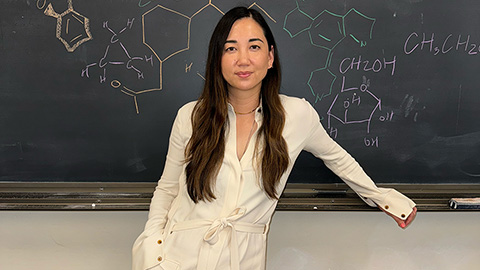Starting a career in data science
Although training in genetics is highly transferable, transitioning out of academia can present a lot of challenges. We interviewed Tara Zeynep Baris to discuss her transition out of academia and into a career in data science.
Baris received her Ph.D. in evolutionary genomics at the University of Miami. Desiring flexibility and a diverse workload, Baris pursued data science through a postdoctoral training opportunity with Insight Data Science.

She then transitioned to a position in research and development for Nielsen, an audience data analytics company for media platforms.
Baris is currently a senior data scientist with HUB Ocean (formerly the Centre for the Fourth Industrial Revolution–Ocean, or C4IR Ocean), which operates under the World Economic Forum.
She shared her experience working in the world of data science and how her Ph.D. training in genomics prepared her for this career path.
How did you decide to transition out of academia?
It wasn’t an easy decision. I love research and having the freedom to explore something to the end. However, I wanted flexibility in where I would live and the ability to try different opportunities until I found the right fit. In contrast, most academics have to follow open positions and become experts in one research domain. Of course you can always learn new things and change slightly, but there isn’t a ton of flexibility as you won’t get a full-time position in an area of research that is completely different from your background.
What were the biggest challenges in transitioning to industry?
In academia, especially as a Ph.D. student, you’re in a learning position. So, when you make mistakes, you aren’t usually held responsible for the financial implications. You just move on and learn. This isn’t always the case when you work for a company. You could potentially cost your company an important client or contract. In industry, you will more frequently feel the pressure to get things right without as much space to learn by making mistakes.Another difference is in the depth of projects. In research, you have the freedom to explore a topic by reading everything in the literature, looking at the data from different perspectives, and then making conclusions. In industry, you don’t have the time to get that level of depth on every project. This was a bit difficult for me because I was used to being completely immersed in what I was researching, but that’s not necessarily what’s needed in industry. Many times I’ve just scratched the surface before a project ends.
The other main challenge is the interviewing process in industry, which was a whole new world to me. For a Ph.D. or a postdoc position, you might give a talk, then meet with faculty and have some laid-back conversations about research.
Data science interviews require an insane amount of preparation. I was quizzed and challenged to demonstrate competency in coding and data science–specific skills through separate specialized interviews. This was a stressful process and took more time to prepare for each set of technical interviews.
What are your day-to-day responsibilities?
Our team’s focus is on building a platform that makes it easy for different types of users to get access to the data that they need to create a more sustainable ocean, whether that’s industry professionals, policymakers or researchers.
I take on a few different roles on the team. First, I do a lot of user interviews and talk to people who will be using our product to make sure that it meets their needs. Second, I work to understand what data is out there, what formats it exists in, and determine how we can make it more accessible to people. This involves working with different types of databases, including geospatial data sets, and then figuring out what actually can be done with the data.
I read papers to understand why certain data is useful. Sometimes that involves working with our partners in different research institutions and universities in Norway to understand the downstream value of that data and coding different functions or working on different models that help people use that data.
Having a research background is really useful in these cases, especially because people from research and industry have very different ways of communicating. It is sometimes easier for me to communicate with researchers because I understand their language and what’s important to them. For example, I’m collaborating with the University of Tromso on an environmental DNA project, which has drawn on a lot from my genomics training.
How does your training compare with other industry data scientists?
When I started my first data science position at Nielsen (a TV ratings company) almost everyone on the team had a Ph.D. in either physics, biology or even fisheries. That was quite a big team compared to where I am now, which has two data scientists and some consultants. The other data scientist I work with now has a background in maritime data but isn’t from a strictly research background.
At first it wasn’t an easy transition for me into industry, but I had really supportive team members who helped me bridge the gap between academic training and what is needed in an industry position.
What do you enjoy most about your position?
I like that I do a lot of different things. That’s important for me personally, as I don’t like doing only one thing repetitively. It’s nice that sometimes I spend my days talking to people and other days I concentrate on coding. I also contribute to big-picture ideas about the direction of our product. So, my favorite thing is that I have my hands in a little bit of everything, and I can be in contact with people on other parts of the project because we’re such a small team. For example, I enjoy trying to understand what the data engineers are doing, learning from them and contributing to their work.
Has your position within a policy-driven organization improved your communication skills?
I give a lot of presentations that include talking about technical things to nontechnical people with a really wide range of expertise. I also present to different industries or government organizations or universities, who are interested in partnering with us. This includes getting them to understand exactly what we do and where we fit in. For this, each presentation has to be tailored to whoever is listening, so I spend a lot of time tweaking presentations and rarely give the same one talk twice.
At the beginning, I struggled a little bit because I’m so used to scientific talks, where I present all of the evidence I have collected and then show how I reached a conclusion after turning over every stone.
In my current position, the small details are not always as relevant. In the beginning, I was giving maybe too much information, as I worried I didn’t have enough data to back up my conclusions. Now, I have learned what’s actually important and focus my talks more narrowly.
What advice do you have for someone thinking about transitioning into data science?
First, it is important to understand what makes you tick as a person to be sure that you’re following a career path with opportunities that will make you happy. Second, be patient. It is really hard to transition to a new career and a new environment. It doesn’t happen overnight, but the skills that you acquire during your Ph.D. will be helpful. Staying determined and continuing to work at it are essential.
Finally, create a support network of people who have the career you want as you are transitioning. I always reach out to people who have gone through the same path and understand their experience and the hurdles they have overcome. They can pass on knowledge that will make it easier for you or even provide resources that you wouldn’t have thought of.
This article first appeared in Genes to Genomes, a blog from the Genetics Society of America. Read the original article here.
Enjoy reading ASBMB Today?
Become a member to receive the print edition four times a year and the digital edition monthly.
Learn moreFeatured jobs
from the ASBMB career center
Get the latest from ASBMB Today
Enter your email address, and we’ll send you a weekly email with recent articles, interviews and more.
Latest in Industry
Industry highlights or most popular articles

How Alixorexton could transform narcolepsy treatment
A new investigational drug, alixorexton, targets the brain’s orexin system to restore wakefulness in people with narcolepsy type 1. Alkermes chemist Brian Raymer shares how molecular modeling turned a lab idea into a promising phase 3 therapy.

Inside industry postdocs
As more Ph.D. scientists look beyond academia, industry postdocs offer a new kind of training, where mentorship meets mission-driven research. Fellows at Pfizer and Genentech share how these programs prepare them to translate discovery into impact.

Black excellence in biotech: Shaping the future of an industry
This Black History Month, we highlight the impact of DEI initiatives, trailblazing scientists and industry leaders working to create a more inclusive and scientific community. Discover how you can be part of the movement.

Attend ASBMB’s career and education fair
Attending the ASBMB career and education fair is a great way to explore new opportunities, make valuable connections and gain insights into potential career paths.

Benefits of attending a large scientific conference
Researchers have a lot of choices when it comes to conferences and symposia. A large conference like the ASBMB Annual Meeting offers myriad opportunities, such as poster sessions, top research talks, social events, workshops, vendor booths and more.

Biotech startup worms its way into therapeutics
Andrea Choe's company, Holoclara, has created an anti-inflammatory drug based on a molecule from worms.

